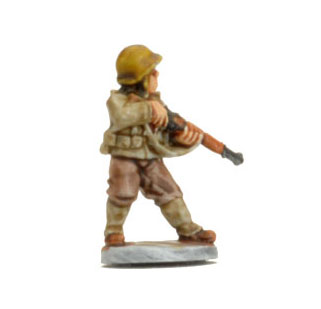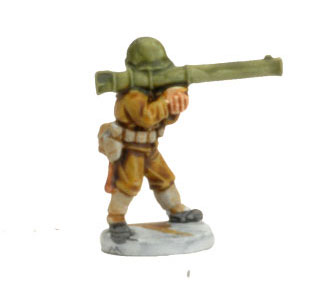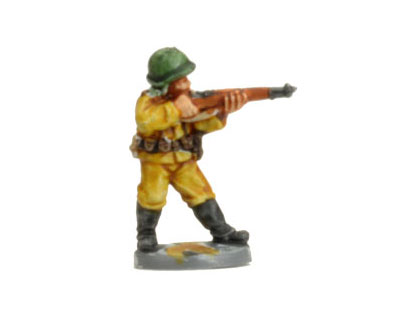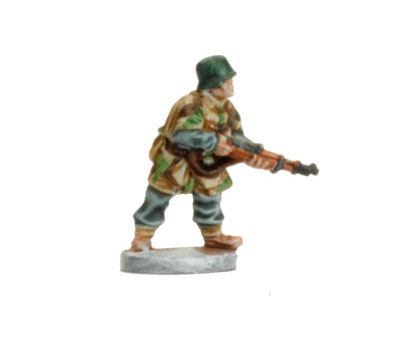|
|
 |
|
|
Contrast on Flames Of War
 |
Contrast on Flames Of War
with Aaron Mathie
The release of Games Workshop’s ‘Contrast’ paint range has set the tabletop wargaming and miniature painting communities alight with the possibilities that this product offers.
We here at BFHQ are just as susceptible to buying a ticket to ride on the hype train as anyone else, so we got hold of some ‘Contrast’ to test it on some of our excellent plastic infantry figures. As with everything in this hobby, our opinion is divided; with some finding the outcome of using Contrast paint on infantry as a fair trade on time versus result, some preferring a more traditional style, and others investigating ideas for speed painting your Landseers, Tommies, GIs and Ivans.
|
|
Please note that some of these figures are painted in Soviet and British colours and do not match their nationality
It should be stated from the outset that there is no one ‘right way’ to go about preparing your armies to engage in combat on the table… although the debate is as heated as any firefight.
|
|
First thing’s first, what is ‘Contrast’ suited for?
In short, Infantry, specifically flesh and cloth, basically organic things. If you find these to be a challenge, or if you have ever wanted to paint a massed Infantry force but have been turned off by the sheer amount of time that it can take, ‘Contrast’ is one solution to your conundrum.
If it is good for organic things, can it be used on inorganic subjects? The answer here is a little bit less clear cut. On small items of equipment, for instance helmets, it works as well as on organic subjects, however your results may be less pleasing on larger inorganic subjects like tanks.
Right Image: The British Colour Scheme on a plastic American Bazooka figure.
|
 |
|
Luckily the solution to this issue is quite simple, as Contrast paints can be mixed with each other which allows you to easily fine tune colours (below are some mixes that I have tried and recommend as a place to start).
|
 |
Contrast isn’t magic and you will still need to paint your miniature, however it will save you some painting steps, namely shading and highlighting.
A cursory search of YouTube will net you many examples of how to best employ this tool, but in essence the best practice (that I have found, your mileage may vary) is to use long vertical strokes with your brush, mopping up any pooling on raised details.
Left Image: The Soviet Colour Scheme on a plastic American Rifleman Figure.
|
| Always use a light coloured primer as Contrast will not work if applied over bare plastic, or a dark undercoat. I have had good results using Vallejo Grey Surface Primer, which allows the colours to adopt a ‘cool’ tone, which is especially good on uniforms, while Vallejo Pale Sand as a base makes the colours adopt a ‘warmer’ tone which is especially good on flesh. Wait for a coat to dry before applying another colour to an area that has had ‘Contrast’ painted onto it. And to block paint the figure making sure to apply the colour to the parts of the miniature where you want that colour, while avoiding parts that you intend to paint a different colour. |
|
The exception to this is painting camouflage cloth. You can indeed paint camouflage cloth with ‘Contrast’, but you need to go from the lightest to darkest colours in the pattern. However, if you follow the advice to allow each coat to dry before applying the next, you will be able to create a shaded and highlighted camouflage pattern.
Now without further ado here are my recommendations for ‘Contrast’ colours to use on World War Two infantry, please consider these as a possible way to achieve the look you are after, as opposed to hard and fast rules.
Right Image: The German Paint Scheme on a German Rifleman figure.
|
 |
|
|
US Army
Trousers – 3 parts Guilliman Flesh and 1 part Wyldwood
Jacket and Webbing – 2 parts Skeleton Horde and 1 part Gryph-Charger Grey
Helmet and painted metal – 2 parts Militarum Green and 1 part Plaguebearer Flesh
|
|
Soviet Army
Uniform – 2 parts Skeleton Horde and 1 part Plaguebearer Flesh
Canvas Webbing – Skeleton Horde
Leather carrying equipment – Cygor Brown
Helmet and painted metal – Militarum Green
|
|
British Army
Uniform – 2 parts Plaguebearer Flesh and 1 part Snakebite Leather
Webbing – Skeleton Horde
Helmets and painted metal – Militarum Green
Denison camo base – Aggaros Dunes
Denison camo green – Creed Camo
Denison camo brown - Wyldwood
|
|
German Army
Uniform – 2 parts Gryph-Charger Grey and 1 part Millitarum Green
Carrying equipment – Cygor Brown
Helmets and painted metal – Gryph-Charger Grey
Splinter camo base – Skeleton Horde, or you could try Aggaros Dunes
Splinter camo green – Ork Flesh
Splinter camo brown – Snakebite Leather
Some universally useful colours;
Wood – Gore-Grunta Fur
Flesh – Darkoath Flesh
Unpainted metal/black – Black Templar
|
|
|
|
|